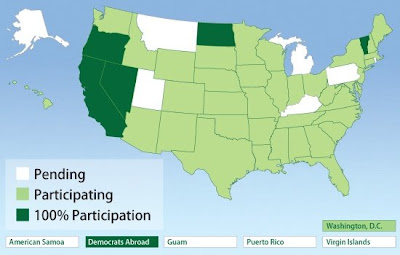Ok so I am a media slut for trying to grab google hits with the title of this post. Still this is a historic convention in oh so many ways.
This story cited below is actually a double steal because it is an AP story from Yahoo:
http://news.yahoo.com/s/ap/20080825/ap_en_mu/cvn_kickoff_concert;_ylt=Ah9QOJ.F0LqqXrNw0QROAa1nhVID
Matthews, Crow kick off Democratic convention
Matthews, playing with Tim Reynolds, was less pointed with his commentary, while Nettles played up the night’s theme of environmentalism. Denver’s mayor has worked with hotels, restaurants and organizers to make the convention a green event.
“This is the first time that a political convention of any sort has been surrounded with the awareness of environmental issues,” Nettles told The AP before playing. “So that feels like it’s on the cutting edge.”
Her bandmate Kristian Bush added: “Yeah, and regardless of what political affiliation you want to align yourself with, this is an issue. It’s real, no matter which side you decide to attack it from.”
Aside from the Dixie Chicks, it’s rare for a country group to play a high-profile Democratic Party-sponsored event. So are Nettles and Bush Democrats?
“We don’t say. We stay away,” replied Nettles, laughing. “It’s like honey, what do you want to be, a pariah? What do you want to be, crucified? It’s a good thing in this country. We don’t have to tell anybody. It’s no one’s business who we vote for.”
Among those who showed up at the event organized by well-connected environmental activist Laurie David: Colorado Gov. Bill Ritter, Virginia Gov. Tim Kaine and Robert Kennedy Jr
:}
Some people think this will be a tall order
:}
http://online.wsj.com/article/SB121434145793701111.html?mod=hps_us_pageone
The Greenest Show
on Earth:
Democrats Gear
Up for Denver
From Organic Fanny Packs to ‘Pure’ Trash,
Party Planners Face Logistical Nightmare
By STEPHANIE SIMON
June 25, 2008; Page A1
DENVER — As the Mile High City gears up to host a Democratic bash for 50,000, organizers are discovering the perils of trying to stage a political spectacle that’s also politically correct.
Consider the fanny packs.
The host committee for the Democratic National Convention wanted 15,000 fanny packs for volunteers. But they had to be made of organic cotton. By unionized labor. In the USA.
Official merchandiser Bob DeMasse scoured the country. His weary conclusion: “That just doesn’t exist.”
Ditto for the baseball caps. “We have a union cap or an organic cap,” Mr. DeMasse says. “But we don’t have a union-organic offering.”
Much of the hand-wringing can be blamed on Denver’s Democratic mayor, John Hickenlooper, who challenged his party and his city to “make this the greenest convention in the history of the planet.”
Convention organizers hired the first-ever Director of Greening, longtime environmental activist Andrea Robinson. Her response to the mayor’s challenge: “That terrifies me!”
After all, the last time Democrats met in Denver — to nominate William Jennings Bryan in 1908 — they dispatched horse-drawn wagons to bring snow from the Rocky Mountains to cool the meeting hall. Ms. Robinson suspected modern-day delegates would prefer air conditioning. So she quickly modified the mayor’s goal: She’d supervise “the most sustainable political convention in modern American history.”
• Campaign dispatches in Washington Wire
• Campaign 2008: Full coverage
Now, she must pull it off.
To test whether celebratory balloons advertised as biodegradable actually will decompose, Ms. Robinson buried samples in a steaming compost heap. She hired an Official Carbon Adviser, who will measure the greenhouse-gas emissions of every placard, every plane trip, every appetizer prepared and every coffee cup tossed. The Democrats hope to pay penance for those emissions by investing in renewable energy projects.
Perhaps Ms. Robinson’s most audacious goal is to reuse, recycle or compost at least 85% of all waste generated during the convention.
:}
Others think it can’t be done. We shall see:
http://www.grist.org/news/2008/07/07/dem_convention/
Bucking Convention
Democratic convention planners struggling to meet big green goals
Posted at 10:13 AM on 07 Jul 2008

Planners of August’s Democratic Convention in Denver are finding that it’s just not that easy to pull off Green Director Andrea Robinson’s goal of “the most sustainable political convention in modern American history.” Only three states’ delegations have agreed to purchase carbon offsets through the convention’s “Green Delegate Challenge” program. Merchandisers despair of finding fanny packs and baseball caps that are organic and made in the U.S. by union labor. Robinson has been unsuccessful in banning bottled water at the convention center. Hotel space in Denver is in short supply, meaning many attendees will likely have to transport themselves by fuel instead of foot. And caterers are balking at what is arguably the convention committee’s most ambitious goal: meals for 40,000 people in which each plate contains 70 percent local and organic ingredients, 50 percent fruits and vegetables, nothing fried, and at “least three of the following five colors: red, green, yellow, blue/purple and white.”
:}
Then there is my friend John Martin who thinks it’s all a JOKE. For a picture of John please see the JOKER in the last Bat Man movie. They say it was Heath Ledger’s last performance but John was his body double and he was in most of the scenes. It’s that smile mon.
http://www.thedrunkablog.blogspot.com/
Click on the August Archives and scrollllllllllll way down.
Monday, August 11, 2008
Wealthy MD: DNC carbon program “endearing”
Doctor and delegate to the Democratic National Convention Mark Thrun on the wisdom of the DNC’s carbon credit program:
$12 bucks is all. $12 bucks and I can erase the carbon footprint I lay down during the course of the Democratic Convention. It seems so cheap.
Now if I wanted to erase my carbon footprint for a year, its gonna cost me a bit more. $324 to be exact. Given the amount I have to drive back and forth in the city, this seems an easy way to assuage my environmental guilt. . . .
Well bully for you, doc. Many people would not find it easy at all. Then this strange, question-begging, cluck-like paragraph:
I love the concept. The fact that we have repeatedly violated air standards for the city this summer makes the project even more endearing. And I am certain to participate [so you haven’t, yet?]. But I have to wonder, if buying carbon offsets is so easy, does it really do anything? I understand where the money is going. And I get the benefits of investments in lower impact energy sources.
Like broken windmills. But underneath his lib vagueness Thrun knows the truth:
Maybe just making a payment will encourage more people to ponder their own impact on the environment. After all, reading recently about real-time home electricity monitors certainly made me envious for a meter. I can easily see me turning off all the lights in the house, obsessively trying to bring the reading down. Maybe the secondary effect of just getting people to think about their own footprint makes web payoffs efficacious.
Payoffs.
Here, by the way, is the latest Green Challenge map from the DNC website:
Compare it to the map from July 28, only three days before the alleged deadline to participate in the offset program:

Truly heroic nagging, is my guess.
Update: So if the good doctor hasn’t bought his offset yet, why is Colorado’s delegation shown in the “100% participation” category? Hmmm?
Update II: The good doctor. Take me now, Jesus.
Update III: The Rocky ends it endless series on Civic Center Park by unleashing student photographers from the Art Institue of Colorado on the place. Man they’re good. Check out the slide show.
Update IV: Oops, the Rocky’s Civic Center series continues, and this is a good one, on the park’s statuary. The first pic is worth the trip.
Labels: democratic national convention










 Earth Day: Save Money and Solve Global Warming Green Your World Victory for the Grand Canyon “Green” Nobel Prize Winner Introducing Green Works
Earth Day: Save Money and Solve Global Warming Green Your World Victory for the Grand Canyon “Green” Nobel Prize Winner Introducing Green Works This
This  You can have an even bigger impact when you help your office, local hospital, schools, or place of worship make better use of efficiency and renewables. You don’t have to reinvent the wheel!We’ve got
You can have an even bigger impact when you help your office, local hospital, schools, or place of worship make better use of efficiency and renewables. You don’t have to reinvent the wheel!We’ve got 
 On April 4, a federal judge issued a restraining order against a mining company and the Kaibab National Forest,
On April 4, a federal judge issued a restraining order against a mining company and the Kaibab National Forest, 
 Puerto Rican grandmother and homemaker Rosa Hilda Ramos has been awarded this year’s prestigious Goldman Environmental Prize, often called “the green Nobel.” In the shadow of polluting factories in Catano, a city across the bay from San Juan, Ramos led her community to successfully defeat a major polluter in court.She then helped direct the funds from the pollution fine to the permanent protection of Las Cucharillas Marsh, one of the last open spaces in the area and one of the largest wetlands ecosystems in the region. Ramos was nominated by the Sierra Club.
Puerto Rican grandmother and homemaker Rosa Hilda Ramos has been awarded this year’s prestigious Goldman Environmental Prize, often called “the green Nobel.” In the shadow of polluting factories in Catano, a city across the bay from San Juan, Ramos led her community to successfully defeat a major polluter in court.She then helped direct the funds from the pollution fine to the permanent protection of Las Cucharillas Marsh, one of the last open spaces in the area and one of the largest wetlands ecosystems in the region. Ramos was nominated by the Sierra Club.  The Sierra Club would like to introduce Green Works, a breakthrough line of natural cleaning products that work as well as traditional cleaners without the harsh chemical fumes or residue. Made from plant- and mineral-based ingredients, Green Works products are a practical way for consumers to live a greener lifestyle without compromising performance.Learn more about Green Works and
The Sierra Club would like to introduce Green Works, a breakthrough line of natural cleaning products that work as well as traditional cleaners without the harsh chemical fumes or residue. Made from plant- and mineral-based ingredients, Green Works products are a practical way for consumers to live a greener lifestyle without compromising performance.Learn more about Green Works and 


